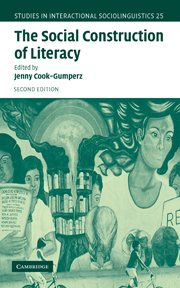Book contents
- Frontmatter
- Contents
- List of figures
- List of tables
- List of contributors
- Preface
- Acknowledgments
- 1 The social construction of literacy
- 2 Literacy and schooling: an unchanging equation?
- 3 Interactional sociolinguistics in the study of schooling
- 4 The language experience of children at home and at school
- 5 Narrative presentations: an oral preparation for literacy with first graders
- 6 Differential instruction in reading groups
- 7 Organizational constraints on reading group mobility
- 8 Developing mathematical literacy in a bilingual classroom
- 9 Spoken language strategies and reading acquisition
- 10 Speaking and writing: discourse strategies and the acquisition of literacy
- 11 The implicit discourse genres of standardized testing: what verbal analogy items require of test takers
- References
- Author index
- Subject index
Preface
Published online by Cambridge University Press: 05 June 2012
- Frontmatter
- Contents
- List of figures
- List of tables
- List of contributors
- Preface
- Acknowledgments
- 1 The social construction of literacy
- 2 Literacy and schooling: an unchanging equation?
- 3 Interactional sociolinguistics in the study of schooling
- 4 The language experience of children at home and at school
- 5 Narrative presentations: an oral preparation for literacy with first graders
- 6 Differential instruction in reading groups
- 7 Organizational constraints on reading group mobility
- 8 Developing mathematical literacy in a bilingual classroom
- 9 Spoken language strategies and reading acquisition
- 10 Speaking and writing: discourse strategies and the acquisition of literacy
- 11 The implicit discourse genres of standardized testing: what verbal analogy items require of test takers
- References
- Author index
- Subject index
Summary
First published in an earlier edition twenty years ago, this book was part of a new wave of studies exploring literacy from anthropological and social historical perspectives that began to appear from the late 1970s, beginning with the publication of Goody's Domestication of the Savage Mind (1977). The volume differs from others in that it focuses on literacy as a sociolinguistic process, in which language and language use in all their ramifications are central to the study of literacy. Most usually described as the production and interpretation of written text, literacy in this volume is seen as interactively and therefore socially constructed through verbal exchanges that take place over time in many communicative settings. It is literacy in this broader sense that defines not just an educated person, but also and more importantly, an educable one.
Like others in the Interactional Sociolinguistics series, this volume seeks to provide insights into the workings of institutional processes in contemporary urban societies through case studies of verbal encounters that typify individuals' experiences in these institutions. The assumption is that many issues that have long been at the center of public debate such as equal access to educational opportunity arise at least in part as a result of inferences and judgments made in the course of everyday interactive experience. By studying the often unstated beliefs and preconceptions on which such judgments are based along with the verbal exchanges in which interactants participate, we can gain an understanding of how evaluations and educational outcomes are socially constructed.
- Type
- Chapter
- Information
- The Social Construction of Literacy , pp. xii - xivPublisher: Cambridge University PressPrint publication year: 2006

